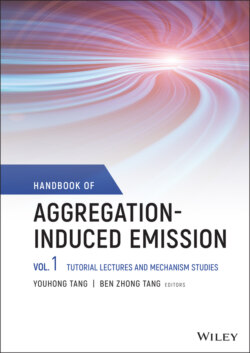Читать книгу Handbook of Aggregation-Induced Emission, Volume 1 - Группа авторов - Страница 16
1.2.1 Restriction of Intramolecular Rotation
ОглавлениеInvestigation of the effect from molecular motions on luminescence processes has drawn increasing interests. The less conjugated structures and intrinsic steric congestions are responsible for the high conformational flexibility of AIEgens.
Taking HPS as the model AIEgen [14a] as shown in Figure 1.1, when HPS is fully dissolved in the THF solution to form the isolated molecular species, it shows almost no emission. With increasing water gradually into the dilute solution and keeping the same concentration, the HPS molecules tend to aggregate due to the hydrophobicity. When the water fraction reaches 60%, notable aggregate forms and the quantum yield of the whole system starts to increase. Further increasing the water fraction, the light emission is continuously enhanced due to the further aggregation. According to general physics, any form of motion can consume energy. When we look into the structure of HPS analyzed from the X‐ray diffraction, it can be found that six phenyl rings are attached to the central silole ring through single bonds with large dihedral angles, which allow free torsion or twisting motions, indicating that motions of phenyl rings are responsible for the energy dissipation in the solution state. With increasing the solvent viscosity by adding the glycerol into the solution or decreasing the temperature of the solution from room temperature to −196 °C, the emission of HPS‐2 can be gradually enhanced due to the constraints coming from the highly viscous solvent or rigidified solvent environment at the low temperature. Furthermore, introducing internal steric hindrance shows a similar effect by attaching the isopropyl groups onto the 2,3,4,5‐positions of the central silole as presented in Figure 1.1d and e [14c]. Crowdedness induced by the bulky groups hampers the torsion of the phenyl rings, then the nonradiative decay process can be restricted, and the emission can be restored.
Figure 1.1 (a) Fluorescence quantum yield of HPS in the acetone/water mixtures with different water fraction. (b) Photoluminescence peak intensity of HPS in the glycerol/methanol mixtures with different glycerol fraction [HPS] = 10−5 M. (c) Photoluminescence peak intensity of HPS‐2 in the 1,4‐dioxane solution at different temperatures. [HPS‐2] = 10−5 M.
Source: Adapted from Ref. [14a] with permission from American Chemical Society.
(d) Chemical structures and fluorescence photos. (e) Photoluminescence spectra of HPS 3−5 in the acetone solution (10−5 M).
Source: Adapted from Ref. [14c] with permission from American Chemical Society.
TPE is another prototype of AIEgens with a similar intrinsic structure as HPS. Four phenyl rings are connected with the central double bond in a highly twisted conformation. As presented in Figure 1.3a, upon excitation, four phenyl rings can drastically twist against the double bond. Meanwhile, the C=C double bond will be weakened due to the photoexcitation, which endows it with strong twisting ability to reorganize the conformation. All these intramolecular motions result in the undetectable emission for TPE in the dilute solution. However, its emission can be dramatically boosted once the aggregation occurs. Further locking the adjacent phenyl rings through chemical bonds or attaching bulky groups onto the phenyl rings of TPE, its emission can be enhanced even in the solution [16]. All these experiments of controlling the internal or external constraints to the intramolecular motions have proved that the RIR mechanism is responsible for the AIE effect of the rotor‐based AIEgens.
